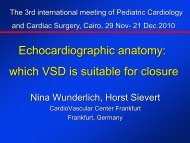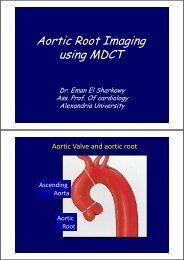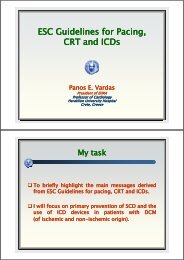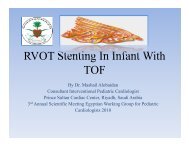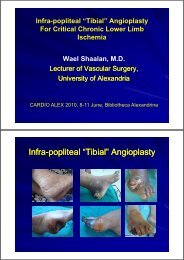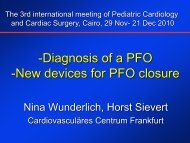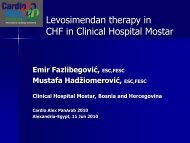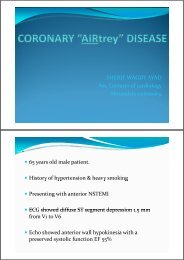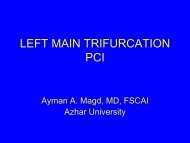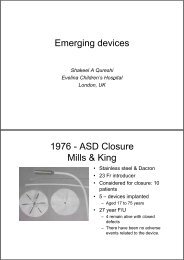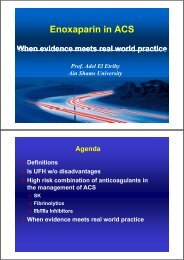Accelerated Atherosclerosis Introduction
Accelerated Atherosclerosis Introduction
Accelerated Atherosclerosis Introduction
You also want an ePaper? Increase the reach of your titles
YUMPU automatically turns print PDFs into web optimized ePapers that Google loves.
<strong>Accelerated</strong> <strong>Atherosclerosis</strong>Mahmoud Hassanein, MDProfessor of CardiologyAlexandria University<strong>Introduction</strong>• Autopsies done on apparently healthy, youngadult casualities of the Korean and Vietnamwars demonstrated a 45% to 77% prevalenceof atherosclerosis of the coronary arteries,suggesting its childhood origins .JAMA 1953 152 1090 1093JAMA 1953;152:1090‐1093JAMA 1971;216:1185‐1187
<strong>Introduction</strong>• The Bogalusa study follow‐up has confirmedthat the atherosclerotic lesions in thecoronary arteries are more prevalent in theyouth with multiple risk factors such thattobacco smoke exposure, dyslipidemia,hypertension and diabetes and that theeffects of childhood obesity on the adultvasculature are cumulative.N Engl J Med 1998;338:1650‐1656Types of vascular injury• Type I vascular injury (nondenuding)functional injury followed by lipidaccumulation, monocyte and plateletadhesion, smooth muscle cell proliferationand resultant plaque formation represents theprevalent view of the early stages ofspontaneous atherogenesis
Types of vascular injury• Type II and type III vascular injury (denudingdiendothelial and intimal injury) with or withoutmedial damage followed by thrombus and itsorganization by smooth muscle cellproliferation and subsequent fibrosis appearto be responsible for the vascular process.• This accelerated and premature occlusiveprocess accounts for significant morbidity andmortality in patients with these conditionsPrevalence and Correlates of <strong>Accelerated</strong><strong>Atherosclerosis</strong> in Systemic Lupus Erythematosus• Methods In 197 patients with lupus and 197matched controls, the investigators performedcarotid ultrasonography, echocardiography,and an assessment for risk factors forcardiovascular disease. The patients were alsoevaluated with respect to their clinical andserologic features, inflammatory mediators,and disease treatmentN Engl J Med 2003;349:2399‐2406
Prevalence and Correlates of <strong>Accelerated</strong><strong>Atherosclerosis</strong> in Systemic Lupus Erythematosus• The risk ikfactors for cardiovascular disease weresimilar among patients and controls.<strong>Atherosclerosis</strong> (carotid plaque) was moreprevalent among patients than the controls (37.1percent vs. 15.2 percent, P
<strong>Accelerated</strong> atherosclerosis inrheumatoid arthritis• Cardiovascular disease is a leading cause ofmortality in rheumatoid arthritis (RA).Endothelial dysfunction often precedesmanifest atherosclerosis.• Both traditional, Framingham risk factors andinflammation‐associated factors are involvedin RA‐associated atherosclerosis.Link Between Small‐vesselVasculitides and <strong>Atherosclerosis</strong>• Premature atherosclerosis has recentlyemerged as a late, but possibly severe,complication of systemic small‐vesselvasculitides, mainly represented by Wegener'sgranulomatosis, microscopic polyangiitis andChurg‐Strauss syndrome
Syndromes of accelerated atherosclerosis• Heart transplant atherosclerosis• Coronary vein graft disease• Restenosis after percutaneous transluminalcoronary angioplastyappear to share etiologic mechanisms withspontaneous atherosclerosis by means of the"response to injury" hypothesis.
Syndromes of accelerated atherosclerosis• In contrast to spontaneous atherosclerosis, amore significant denuding endothelial injuryappears to be the critical initiating event,followed by intense platelet involvement andthrombus formation, leading to an initialpredominant process of smooth muscle cellproliferationDiabetes‐accelerated accelerated atherosclerosis• There is increasing i evidence that advanceddglycation end‐products(AGE) and theirinteraction ti with the receptor RAGE play a pivotalrole in atherosclerosis, in particular in the settingof diabetes.• Previous studies have shown that inhibition ofAGE accumulation and RAGE expression indiabetes by either reduction of the formation ofAGEs or cross‐link breakers was associated itdwithreduced atherosclerosis and renal disease.
HIV‐infections and acceleratedatherosclerosis• HIV‐infected patients t may be prone to thrombosisand accelerated atherosclerosis of the coronaryarteries while they are treated with proteaseinhibitors (PIs), such as indinavir.• This may be a direct result of drug exposure oran indirect result of hyperlipidemia associatedwith PI treatment; the precise mechanism isunknown.• PIs, such as indinavir, are associated with portalvein thrombosis and accelerated atherosclerosisof the coronary arteries in HIV‐infected patientsComponents of cardiovascularPreventionCigarette smoking cessationBlood pressure controlLipid management to goalPhysical activityWeight management to goalDiabetes management to goalAntiplatelet agents / anticoagulantsRenin angiotensin i aldosterone system blockersBeta blockersInfluenza vaccination18
Cigarette Smoking RecommendationsGoal: Complete Cessation and No Exposure toEnvironmental Tobacco SmokeIIIa aIIb bIII•Ask about tobacco use status at every visit.•Advise every tobacco user to quit.•Assess the tobacco user’s willingness to quit.•Assist by counseling and developing a plan forquitting.•Arrange follow-up, referral to special programs,or pharmacotherapy (including nicotinereplacement and bupropion.•Urge avoidance of exposure to environmentaltobacco smoke at work and home.19Blood Pressure Control RecommendationsGoal:
JNC VII Lifestyle Modifications for BP ControlModification Recommendation Approximate SBPReduction RangeWeight reductionAdopt DASHeating planMaintain normal body weight (BMI=18.5-24.9)Diet rich in fruits, vegetables, low fatdairy and reduced in fat5-20 mmHg/10 kg weightlost8-14 mmHgRestrict sodium
Definition of the Metabolic SyndromeDefined by presence of >3 risk factorsRisk FactorDefining LevelWaist circumference (abdominal obesity)>40 in (>102 cm) in men>35 in (>88 cm) in womenTriglyceride levelHDL-C level>150 mg/dl85 mmHgFasting glucose>100 mg/dlHDL-C=High-density lipoprotein cholesterolGrundy, et al. Diagnosis and management of the metabolic syndrome: an AHA/NHLBI Scientific Statement.Circulation 2005;112:2735-2752.25Diabetes Mellitus RecommendationsGoal: Hb A1c < 7%IIIIIa IIb IIIIIa IIb IIIIIa IIb IIILifestyle and pharmacotherapy py to achieve nearnormal HbA1C (
Aspirin ®in men (meta‐analysis)analysis)• Meta‐analysis analysis of the five primary preventionstudies (HOT, PPP, PHS, BDT, TPT)• > 44,000 male patients• No significant risk reductionfor a first ischemic stroke32%• Significant risk reductionfor a first non‐fatalmyocardial infarctionHOT – Hypertension Optimal Treatment trialPPP – Primary Prevention ProjectPHS – Physicians‘ Health StudyBDT –British Doctors‘ TrialTPT –Thrombosis Prevention TrialRisk reduction for a first nonfatalmyocardial infarction(p=0.001)Berger et al, JAMA 2006;295:306 ‐ 313Low dose Aspirin ® : significant reductionof non‐fatal re‐infarction and mortalityin secondary prevention765765aspirinControl groupEvent rat te (%)43210Non‐fatal re‐infarctionEvent rat te (%)43210Vascular death28%Reduction of nonfatalre‐infarction(p
ACE Inhibitor Evidence: CAD, CVD, PVD or DMHeart Outcomes Prevention and Evaluation (HOPE) Study9,297 patients with DM or vascular disease plus one additional CV risk factor, but withoutHF or known LVSD randomized to ramipril (10 mg) or placebo for 5 yearsCV deat th, MI, orstrok ke (%)020 0.200.15010 0.100.050.00RamiprilPlacebo22% RRR, P
Conclusions• Understanding the mechanisms of acceleratedatherosclerosis may help to include strategies to limitvascular injury and reduce subsequent thrombotic andproliferating cellular responses.• In contrast to spontaneous atherosclerosis, a moresignificant denuding endothelial injury appears to bethe critical initiating iti event, followed by intenseplatelet involvement and thrombus formation.• Traditional risk factors like cigarette smoking andhypertension and dyslipidemia still play an importantrole in this process



